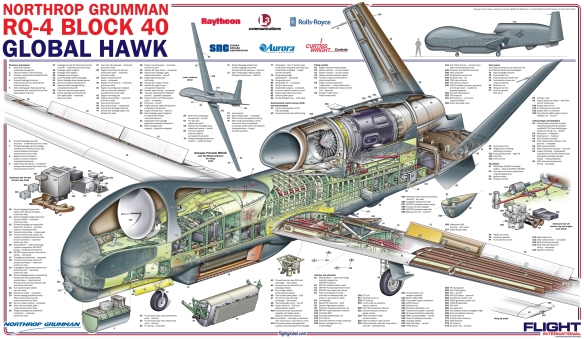UAV Roles Unmanned Airborne Vehicles (UAVs) have become an important part of modern warfare. They can provide a range of functions, including:
- remote sensing, including optical and radio surveillance;
- direction finding;
- over the horizon targeting;
- communications relay ;
- stand-on jamming;
- interdiction, using Unmanned Combat Airborne Vehicles (UCAVs) ;
- local surveillance, using very small UAVs.
Hundreds of types of UAV are in service or development, covering everything up to strategic roles. Design and operational considerations vary considerably according to size, role, performance and endurance. Most UAV s require a command and control link and also a telemetry link to transmit the data they are collecting. In many cases, there will also be a vehicle telemetry system to transfer flight data back from the aircraft to the control centre.
Communications to and from the UAV may pass via satellites for strategic systems, via airborne communications relays or straight to and from ground control stations. Airborne communications relays may be aircraft or other UAVs. The routes shown in the figure may have more than one set of links; there may be others for redundancy.
UAV Advantages
UAV s have clear advantages over other systems in certain cases. Compared to ground systems, they have the advantage of altitude and unobstructed paths to and from potential target systems. As they are unmanned, they can be sent forward to areas that are more dangerous to perform stand-in jamming, surveillance or radio localisation tasks. They are cheaper to operate than manned aircraft. The scalability of UAVs allows them to be used for a variety of tasks. Very small systems can be used at the tactical level by units as small as squads to provide intelligence collection over the next hill or around the next street corner. Low-cost, simple to use systems can be widely issued to units for tactical tasks of a few kilometres. Larger systems can be used to provide surveillance tens of kilometres into enemy territory at the expense of larger cost, logistic’ and operational issues.
UAVs are also finding roles in other areas such as policing, border monitoring, surveys of power lines and areas of interest. It is not difficult to imagine the role they could play in providing real-time images for emergencies and for natural disasters.
UAV Disadvantages
If UAVs have such obvious, advantages, do they have any disadvantages? As with any other system they do. Large UAVs are more vulnerable to ground fi re and they would stand no chance against airborne interception aircraft. If control of them is lost due to damage or system failure, large UAVs can cause significant damage on the ground and recovered UAVs are intelligence gold for technical specialists looking to find out how the most modern systems work.
UAVs are not totally autonomous and do rely on communications to function correctly. Interrupts to command control can be tolerated to a greater or lesser extent, but it communications are lost the mission will be terminated at some point. The most sophisticated systems may be programmed to return to base or specific points to allow communications to be re-established if possible, but others will lose control and crash.
UAVS, in common with other aircraft, have limited time on task. Depending on their design, they can loiter for a certain length of time in the target area but then they have to return to base for re-fuelling and maintenance. Also, the aircraft are flown remotely and their pilots also require rest. This means that just like manned aircraft, many UAV s are required to maintain extended coverage. Another key issue is the power available required onboard to supply the UAV systems and payloads. This places severe power management issues on the design of all vehicle sub-systems. Jammers in particular have limited power and must be managed to ensure that their power is not exhausted too early. This constraint adds to design cost and operational mission management. UAV systems also pose potential airspace management problems with other airspace users. Since they are unmanned, they cannot react to other traffic in the same way that a manned aircraft can. It may be necessary to block off large parts of airspace and flight levels to ensure that other aircraft remain clear. In dynamic military environments, this is inefficient.
